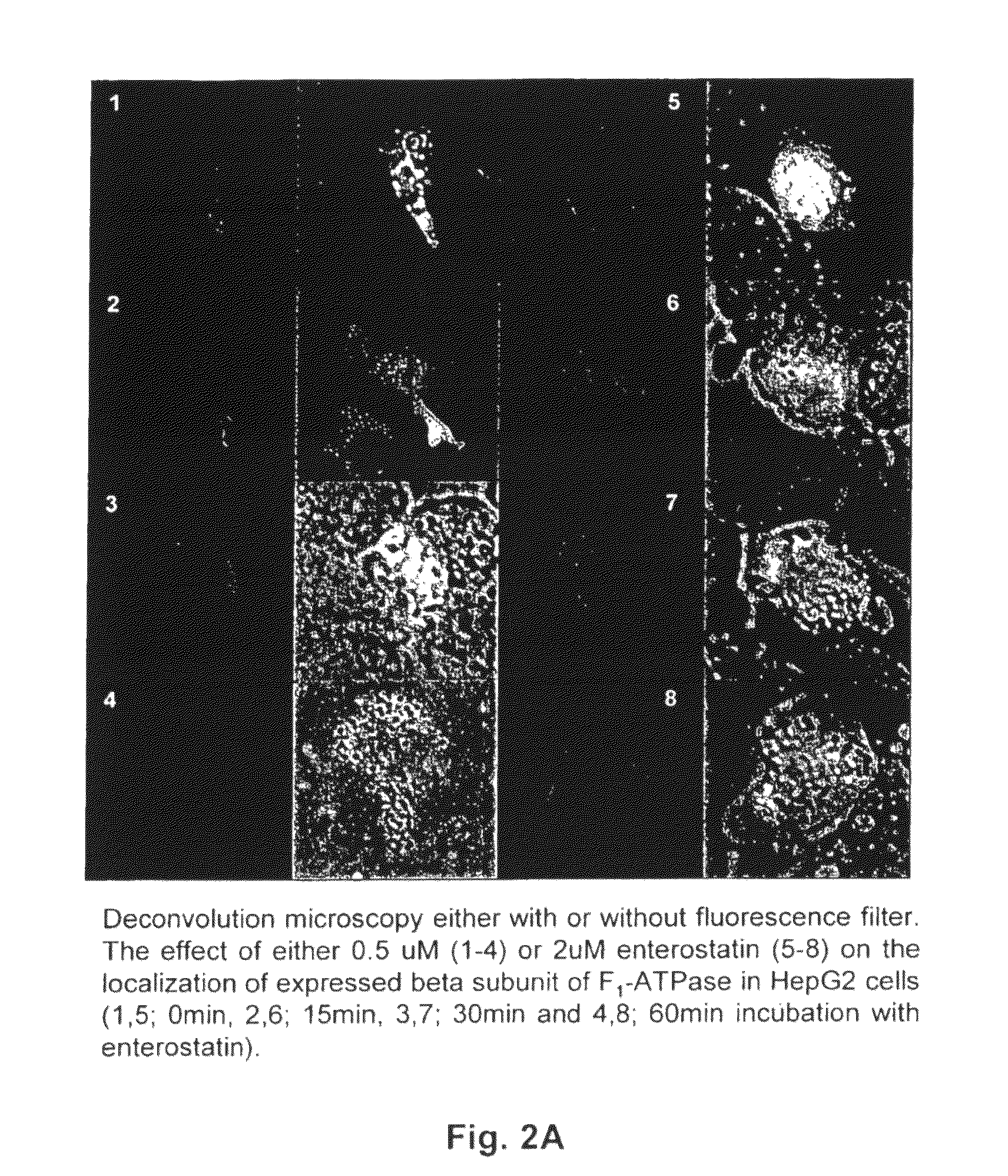Regulation of F1-ATPase beta subunit cellular location
a subunit and cellular location technology, applied in the field of f1-atpase beta subunit cellular location regulation, can solve the problems of limited enterostatin absorption across the intestine, inability to detect enterostatin selectively, and inability to analyze enterostatin in vivo, so as to improve the activity of plasma membrane atpase, improve the binding affinity of apoa-1, and affect the effect of cholesterol transpor
- Summary
- Abstract
- Description
- Claims
- Application Information
AI Technical Summary
Benefits of technology
Problems solved by technology
Method used
Image
Examples
example 1
[0032]Materials and Methods
[0033]Generation of F1-ATPase beta subunit-GFP fusion protein. The F1-ATPase β-subunit clone (1,254 bp) was generated by PCR from an amygdala cDNA library using F1-ATPase β-subunit forward primer (5′GAGAGGAGCTCCACTATTGCTATGGATGGC3′ (SEQ ID NO. 1), Sac I recognition site underlined) and F1-ATPase β-subunit reverse primer (5′GAGAGAAGCTTCACGACCCATGCTC3′ (SEQ ID NO. 2), Hind III recognition site underlined), according to procedures described in Appendix B. The PCR product was cloned into the pEGFP-C1 vector (Clonetech, Palo Alto, Calif.) between the Sac I and Hind III sites as shown in FIG. 1A. The construct was then transformed into DH5α cells. Transformants were screened and positive clones containing plasmid with the correct orientation of the insert were cultured.
[0034]Generation of F1-ATPase alpha subunit-RFP fusion protein. The F1-ATPase α-subunit clone (1,662 bp) was generated by PCR from an amygdala cDNA library using F1-ATPase α-subunit forward primer...
example 2
[0036]Enterostatin Alters F1-ATPase Beta Subunit Cell Location in HepG2 Cells
[0037]Either 0.5 or 2 μM enterostatin was added to the HepG2 cells after transfection with either alpha subunit-RFP or beta subunit-GFP for 16-18 hrs. After incubation with enterostatin for 15, 30, or 60 min, the cover slide was removed from the well and placed on a glass slide. Protein expression in HepG2 cells was then observed using deconvolution microscopy.
[0038]Enterostatin did not change the distribution of expressed F1-ATPase alpha subunit-RFP in HepG2 within the time of incubation with either concentration of enterostatin (FIG. 2B). However, after incubation with both 0.5 and 2 uM enterostatin, F1-ATPase beta subunit-GFP was clearly relocated toward the cell periphery (FIG. 2A). To study this event in real time, a confocal microscope with an inverted camera was used to observe protein localization in transfected HepG2 cells at the different incubation times with 2 μM enterostatin for both the beta s...
example 3
[0039]F1-ATPase Beta Subunit in Plasma Membrane of Liver, Pancreas and Amygdala Cells
[0040]Using Western blot analysis and immunohistochemistry, F1-ATPase β-Subunit was discovered present in the plasma membrane and mitochondrial membranes of liver, pancreas and amygdala cells from rats. The purified F1-ATPase β-Subunit (200 μg / ml) (produced as described in Appendix B) in Freunds complete adjuvant (Sigma Chemical Co., St. Louis, Mo.) was injected subcutaneously at multiple sites on the back of New Zealand white rabbits. Booster doses, diluted into Freunds incomplete adjuvant, were administered at weeks 4, 8 and 12. Blood was collected from injected animals on weeks 0, 4, 8, and 12. Rabbit antiserum was prepared by centrifugation (2000×g, 30 min, 4° C.) and stored at −20° C. in aliquots. The antibody was purified by passing over a protein A bead column (Sigma Chemical Co.). The antibody dilution necessary for antigen detection was assayed by an ELISA. Ninety six-well plates were coate...
PUM
| Property | Measurement | Unit |
|---|---|---|
| total volume | aaaaa | aaaaa |
| pH | aaaaa | aaaaa |
| pH | aaaaa | aaaaa |
Abstract
Description
Claims
Application Information
 Login to View More
Login to View More - R&D
- Intellectual Property
- Life Sciences
- Materials
- Tech Scout
- Unparalleled Data Quality
- Higher Quality Content
- 60% Fewer Hallucinations
Browse by: Latest US Patents, China's latest patents, Technical Efficacy Thesaurus, Application Domain, Technology Topic, Popular Technical Reports.
© 2025 PatSnap. All rights reserved.Legal|Privacy policy|Modern Slavery Act Transparency Statement|Sitemap|About US| Contact US: help@patsnap.com



